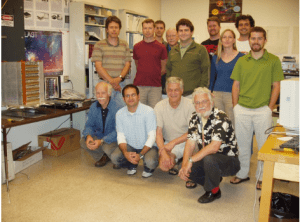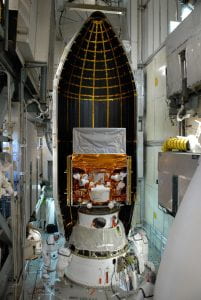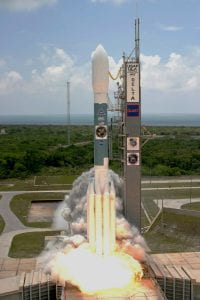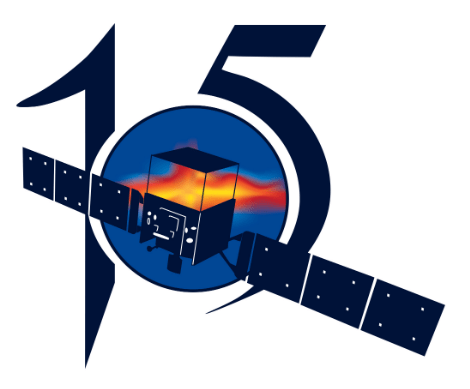SCIPP celebrates 15 years of looking into the gamma-ray sky with the Fermi satellite.
The Fermi mission was launched on the 11th of June, 2008 into low-earth orbit, and it has been scanning the gamma-ray sky since then. Its findings have been published in over 5000 publications, including over 30 in Science or Nature. The Santa Cruz Institute of Particle Physics has been deeply involved in the program since its beginning and is today maintaining an active program of analyzing and interpreting the observations.
Fermi at SCIPP:
SCIPP’s work on the Fermi mission started in 1994, 14 years prior to launch, when Professor Robert Johnson began studying electronics design for the silicon-strip tracking readout. The work at SCIPP was essential for the design concept, the successful proposals to NASA and the Department of Energy (DOE), and research and development of the Fermi Large Area Telescope (LAT), including tests in a balloon flight and laboratory test beams. Since gamma rays are high energy particles, SCIPP’s expertise in High Energy Particle Physics instrumentation, developed for accelerator facilities like SLAC and CERN, was crucial in this process. It allowed the team to explore and select the most advanced but proven sensor technologies for a large-scale satellite, where low electric power consumption is a major requirement.
 Some members of the Fermi group
Some members of the Fermi group
@ SCIPP in the late 2000’s, around
the time of launch. Bottom row: Bill
Atwood, Bulent Kiziltan, Hartmut
Sadrozinski, and Terry Schalk
Middle row: Robert Johnson, Troy
Porter, Pablo Saz Parkinson, Tesla
Jeltema, Brandon Anderson Back
row: Rudy Gilmore, Joel Primack,
Michael Doromody, Stefano Profumo
The idea of the Fermi mission was born in 1992 with SCIPP Adjunct Professor Bill Atwood (then at Stanford) working with Stanford’s Peter Michelson to figure out how best to measure the direction of the elusive gamma rays from space, to locate their sources in the sky. This is accomplished by 36 layers of segmented high-tech silicon detectors read out by low-power ASICs (“chips”) developed in collaboration with SLAC under the lead of Professor Johnson. The 9216 silicon-strip sensors in the instrument, covering an area of 80 square meters were designed and manufactured under the lead of adjunct Professor Hartmut Sadrozinski, in collaboration with Hiroshima University, by the Japanese company Hamamatsu Photonics. Professor Johnson led the international collaboration that designed, fabricated, and tested the Fermi-LAT silicon-strip based tracking instrument for NASA. Professor Steven Ritz (then at NASA Goddard Space Flight Center) served as the Fermi Mission project scientist and LAT Deputy PI before joining SCIPP after the first year of data taking.
SCIPP led the development of the event analysis for GLAST (renamed Fermi after launch). Atwood focused on the reconstruction of gamma-ray events, and in distinguishing them from an enormous background of cosmic rays. The Fermi LAT became one of the first high energy particle instruments to embrace machine learning, achieving an efficiency and rejection capability many times that attainable using the standard cut-on-variable approach previously employed in the field. This software package was used during the first several years of Fermi LAT’s operation during which time many discoveries were made, and the first LAT gamma-ray catalog of sources was created.


The main steps in realizing the design of the Silicon Tracker were done by SCIPP’s technical staff post-docs and students. It involved among others the construction of the first full-size prototype used to prove the space worthiness in beam tests and a balloon flight, which was supported by high-school teachers participating in the SCIPP teacher outreach program. The final construction and assembly of the Fermi LAT was a collaboration of SCIPP and SLAC, US Naval Research Laboratory, Italy’s INFN and ASI, France’s CNRS/IN2P3,
and NASA’s Goddard Space Flight Center.
Atwood and Johnson also invented a brand-new search algorithm
to find gamma-ray pulsars. Their time-differencing technique proved to be many orders of magnitude more efficient that previously achieved. Using these new techniques, members of the SCIPP pulsar group, including Marcus Ziegler and Pablo Saz Parkinson discovered numerous previously unknown radio-quiet gamma-ray pulsars during the checkout phase of the mission! This result was considered the runner-up scientific break-through of the year in 2009 by the journal Science, and was also featured on the cover of the August 2019 issue. Ritz led the LAT Collaboration’s Dark Matter and New Physics Group, which published numerous unique constraints on the nature of dark matter. Over the years, many SCIPPers have been leaders in novel uses of Fermi data, including all the people mentioned above, post-doc Regina Caputo, and faculty members Stefano Profumo, Tesla Jeltema, David Williams, Joel Primack, and their many students.

